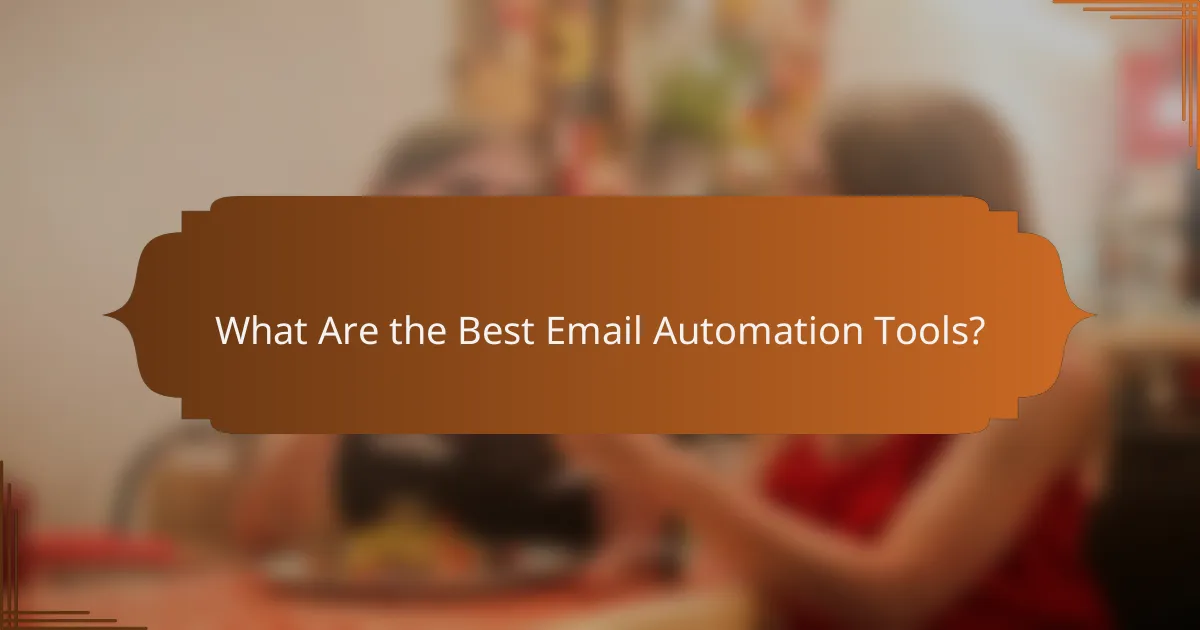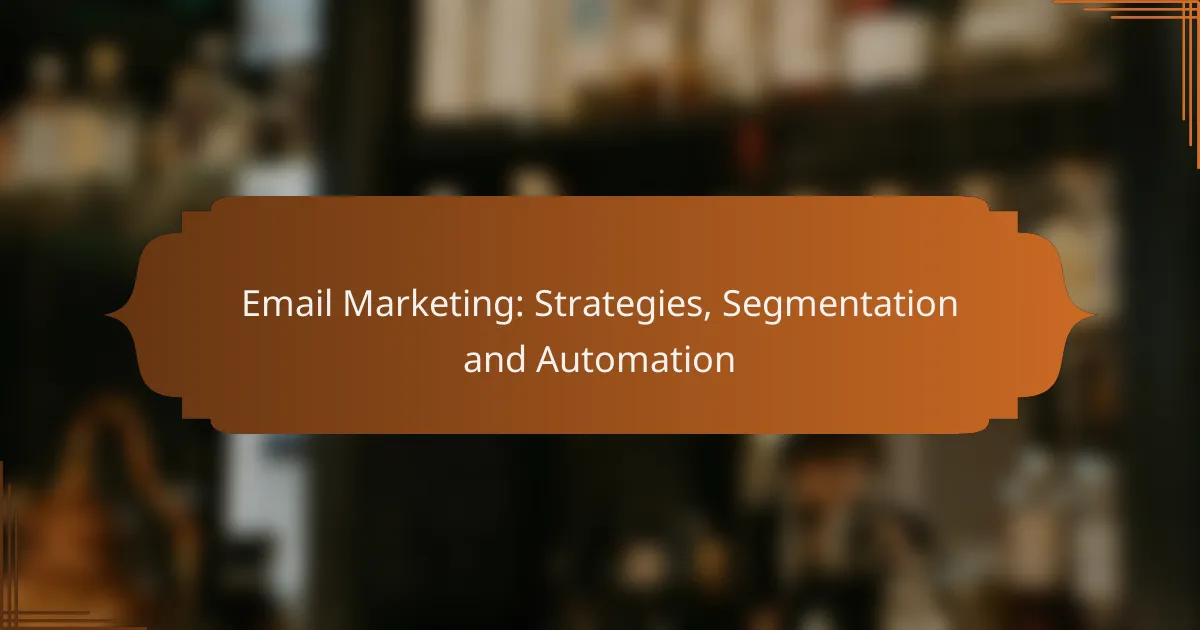Email marketing is a powerful tool for e-commerce businesses, enabling them to engage customers through targeted messaging and personalized content. By implementing effective strategies, segmenting audiences, and utilizing automation tools, businesses can enhance customer loyalty, boost conversion rates, and drive sales. Understanding these key components is essential for maximizing the impact of your email marketing efforts.

What Are Effective Email Marketing Strategies for E-commerce?
Effective email marketing strategies for e-commerce focus on engaging customers through targeted messaging, personalized content, and automated workflows. These strategies aim to boost conversion rates, enhance customer loyalty, and ultimately drive sales.
Personalization Techniques
Personalization techniques involve tailoring emails to individual customer preferences and behaviors. This can include using the recipient’s name, recommending products based on past purchases, or sending tailored offers based on browsing history.
To implement personalization, segment your email list based on demographics, purchase history, and engagement levels. Tools like dynamic content can help create unique experiences for different segments, enhancing relevance and engagement.
Content Segmentation
Content segmentation divides your email list into distinct groups based on specific criteria such as interests, purchase frequency, or geographic location. This allows for more targeted messaging that resonates with each segment.
For example, you might send seasonal promotions to customers in colder regions while offering summer sales to those in warmer areas. Regularly update your segments to reflect changes in customer behavior and preferences.
A/B Testing Approaches
A/B testing involves comparing two versions of an email to determine which performs better. This can include testing subject lines, call-to-action buttons, or email layouts to see what resonates most with your audience.
Start with small changes and analyze metrics such as open rates and click-through rates. Aim for a statistically significant sample size to ensure reliable results, and apply successful elements to future campaigns for continuous improvement.
Customer Journey Mapping
Customer journey mapping visualizes the steps a customer takes from initial awareness to final purchase. Understanding this journey helps identify key touchpoints where email marketing can effectively engage customers.
Consider creating targeted campaigns for each stage of the journey, such as welcome emails for new subscribers, cart abandonment reminders, and post-purchase follow-ups. This approach fosters a more cohesive and supportive customer experience.
Engagement Metrics Analysis
Engagement metrics analysis involves tracking key performance indicators (KPIs) to evaluate the effectiveness of your email campaigns. Important metrics include open rates, click-through rates, conversion rates, and unsubscribe rates.
Regularly review these metrics to identify trends and areas for improvement. Use insights gained from the analysis to refine your strategies, ensuring your emails remain relevant and engaging to your audience.

How to Segment Your Email List?
Segmenting your email list involves dividing your audience into smaller groups based on specific criteria, allowing for more targeted and effective communication. This strategy enhances engagement and improves conversion rates by delivering relevant content to each segment.
Demographic Segmentation
Demographic segmentation focuses on characteristics such as age, gender, income, and education level. By understanding these factors, you can tailor your messaging to resonate with different audience segments. For example, a luxury brand might target higher-income individuals with exclusive offers, while budget-friendly products may appeal to a broader audience.
When implementing demographic segmentation, consider collecting data through sign-up forms or surveys. Ensure that your approach complies with data protection regulations, such as GDPR in Europe, to maintain user trust.
Behavioral Segmentation
Behavioral segmentation categorizes your audience based on their interactions with your brand, including purchase history, email engagement, and website activity. This method allows you to send personalized messages based on user behavior, such as re-engagement campaigns for inactive subscribers or upsell offers for recent buyers.
To effectively use behavioral segmentation, track user actions and analyze patterns. Utilize marketing automation tools to trigger specific emails based on user behavior, ensuring timely and relevant communication.
Geographic Segmentation
Geographic segmentation divides your audience based on their location, such as country, region, or city. This approach is particularly useful for businesses with location-specific products or services, allowing you to tailor your messaging to local preferences and cultural nuances.
When employing geographic segmentation, consider factors like time zones for scheduling emails and local holidays for promotions. This ensures that your campaigns are timely and culturally relevant, enhancing the likelihood of engagement.
Psychographic Segmentation
Psychographic segmentation focuses on the attitudes, interests, and lifestyles of your audience. This deeper understanding allows you to create content that aligns with their values and motivations, fostering a stronger connection with your brand.
To implement psychographic segmentation, conduct surveys or analyze social media interactions to gather insights into your audience’s preferences. Tailor your messaging to reflect their interests, such as promoting eco-friendly products to environmentally conscious consumers.

What Are the Best Email Automation Tools?
The best email automation tools streamline your marketing efforts, enhance customer engagement, and improve conversion rates. Popular options include Mailchimp, ActiveCampaign, and Klaviyo, each offering unique features tailored to different business needs.
Mailchimp Features
Mailchimp is known for its user-friendly interface and robust automation capabilities. It allows users to create targeted campaigns based on customer behavior, segment lists, and schedule emails easily.
Key features include customizable templates, A/B testing, and detailed analytics. Mailchimp also offers a free tier, making it accessible for small businesses and startups.
ActiveCampaign Benefits
ActiveCampaign excels in advanced automation and CRM integration, making it ideal for businesses looking to enhance customer relationships. Its automation workflows can trigger actions based on user interactions, ensuring timely communication.
This platform provides features like lead scoring, tagging, and personalized messaging, which can significantly boost engagement rates. ActiveCampaign is particularly beneficial for mid-sized to large businesses that require more sophisticated marketing tools.
Klaviyo Integrations
Klaviyo is designed for e-commerce businesses, offering seamless integrations with platforms like Shopify and Magento. This allows for real-time data syncing, enabling highly personalized email campaigns based on customer purchase history.
With features like dynamic product recommendations and automated cart abandonment emails, Klaviyo helps businesses recover lost sales effectively. Its pricing model is based on the number of contacts, making it scalable for growing e-commerce brands.

How to Measure Email Marketing Success?
Measuring email marketing success involves analyzing key performance indicators (KPIs) that reflect how well your campaigns engage recipients. Focus on metrics like open rates, click-through rates, and conversion rates to gauge effectiveness and optimize future efforts.
Open Rates Tracking
Open rates indicate the percentage of recipients who opened your email, serving as a primary measure of engagement. A typical open rate ranges from 15% to 25%, depending on the industry and audience.
To improve open rates, consider optimizing subject lines and sending times. A/B testing different subject lines can reveal what resonates best with your audience.
Click-Through Rates Analysis
Click-through rates (CTR) measure the percentage of recipients who clicked on links within your email. A good CTR generally falls between 2% and 5%, though this can vary by sector.
Enhancing your CTR involves clear calls to action (CTAs) and engaging content. Ensure that links are prominently placed and relevant to the email’s purpose to encourage clicks.
Conversion Rate Evaluation
Conversion rates reflect the percentage of recipients who completed a desired action, such as making a purchase or signing up for a newsletter. Typical conversion rates can range from 1% to 5%, depending on the offer and audience targeting.
To boost conversion rates, align your email content with landing page experiences. Use compelling offers and ensure a seamless transition from email to the landing page to maximize conversions.



